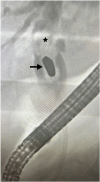Management of obstructive jaundice induced by a retained bullet in the common hepatic duct: A case report
- PMID: 40765730
- PMCID: PMC12322595
- DOI: 10.5339/qmj.2025.62
Management of obstructive jaundice induced by a retained bullet in the common hepatic duct: A case report
Abstract
Background: Traumatic injuries to the extrahepatic bile ducts are rare, with an incidence of 0.4%-0.6% in cholecystectomy procedures among adults, particularly following the introduction of laparoscopic cholecystectomy. Among these, the presence of foreign bodies within the biliary tree is exceptionally rare, with obstructive jaundice caused by a bullet lodged in the common hepatic duct being particularly uncommon. This case report aims to share the diagnostic process and the challenges in managing such a rare condition.
Case presentation: A 41-year-old female with a 13-year history of an accidental gunshot wound, which required an emergency laparotomy, presented to our hospital with symptoms of cholangitis. Endoscopic retrograde cholangiopancreatography was performed, revealing a bullet that caused significant dilation of the proximal bile duct. Exploratory laparoscopy, cholecystectomy, and intraoperative cholangiography confirmed the presence of the bullet. The procedure included a choledochotomy and removal of the bullet, followed by primary closure of the common bile duct using interrupted 4-0 Prolene sutures. The patient was discharged on the 11th postoperative day, and follow-up revealed complete resolution of symptoms and normal liver function.
Discussion: This case underscores the rarity and complexity of managing extrahepatic bile duct injuries caused by foreign bodies. The delayed presentation of symptoms and the unique diagnostic challenges highlight the necessity for meticulous imaging. The successful surgical intervention in this case highlights the importance of individualized treatment strategies implemented by a multidisciplinary team.
Conclusion: Managing traumatic injuries to the extrahepatic bile ducts requires careful consideration due to their rarity and complexity. The challenges in diagnosis and treatment underscore the necessity of a multidisciplinary approach.
Keywords: Obstructive jaundice; biliary surgery; bullet injury; common hepatic duct; foreign body.
© 2025 Zamboni, Drago, Fregonese, Reverendo, Sarotto, licensee HBKU Press.
Conflict of interest statement
The authors declare that they have no competing interests.
Figures




Similar articles
-
Contracted or Vanishing Gallbladder: A Case Report.Cureus. 2025 May 19;17(5):e84382. doi: 10.7759/cureus.84382. eCollection 2025 May. Cureus. 2025. PMID: 40539150 Free PMC article.
-
Hepaticojejunostomy and long-term interventional treatment for recurrent biliary stricture after proximal bile duct injury: A case report.World J Clin Cases. 2025 Jul 16;13(20):104609. doi: 10.12998/wjcc.v13.i20.104609. World J Clin Cases. 2025. PMID: 40671740 Free PMC article.
-
Laparoscopic-endoscopic rendezvous versus preoperative endoscopic sphincterotomy in people undergoing laparoscopic cholecystectomy for stones in the gallbladder and bile duct.Cochrane Database Syst Rev. 2018 Apr 11;4(4):CD010507. doi: 10.1002/14651858.CD010507.pub2. Cochrane Database Syst Rev. 2018. PMID: 29641848 Free PMC article.
-
Endoscopic retrograde cholangiopancreatography versus intraoperative cholangiography for diagnosis of common bile duct stones.Cochrane Database Syst Rev. 2015 Feb 26;2015(2):CD010339. doi: 10.1002/14651858.CD010339.pub2. Cochrane Database Syst Rev. 2015. PMID: 25719222 Free PMC article.
-
NIH state-of-the-science statement on endoscopic retrograde cholangiopancreatography (ERCP) for diagnosis and therapy.NIH Consens State Sci Statements. 2002 Jan 14-16;19(1):1-26. NIH Consens State Sci Statements. 2002. PMID: 14768653
References
-
- Kapoor VK, BjörnTörnqvist . In: Post-cholecystectomy bile duct injury. Singapore:: Springer Singapore;; 2020. Epidemiology of bile duct injury; p. 11–19. p.
-
- Alexander HC, Bartlett AS, Wells CI, Hannam JA, Moore MR, Poole GH, et al. Reporting of complications after laparoscopic cholecystectomy: a systematic review. HPB (Oxford) 2018;;20:786–94. - PubMed
-
- Booij KAC, de Reuver PR, van Dieren S, van Delden OM, Rauws EA, Busch OR, et al. Long-term impact of bile duct injury on morbidity, mortality, quality of life, and work related limitations. Ann Surg. 2018;;268:143–50. - PubMed
Publication types
LinkOut - more resources
Full Text Sources
